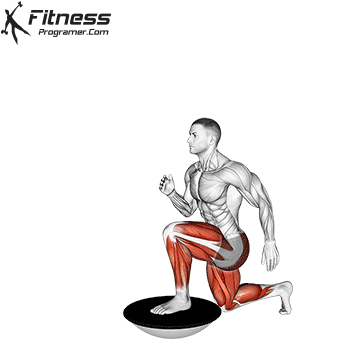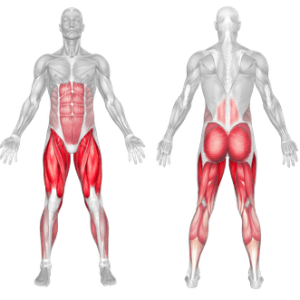Reverse Lunge With Knee Raise On Bosu
The Reverse Lunge with Knee Raise on a Bosu Ball is a challenging unilateral bodyweight exercise that combines strength, stability and balance. This exercise targets multiple muscle groups, including the quadriceps, hamstrings, glutes, and core muscles. The unstable surface of the BOSU intensifies muscle activation in the legs and core, while the knee raise adds an athletic, functional component. It’s ideal for athletes, rehab clients, and anyone looking to improve single-leg strength and control.
How to perform:

- Flip the Bosu Ball around so that the flat side is facing up.
- Lift one foot and step onto the center of the Bosu Ball, ensuring that your foot is centered on the platform.
- Lower your body into a reverse lunge position.
- As you push back up from the lunge position, lift your back knee up towards your chest, bringing it as high as comfortable.
- The instability of the surface will engage your stabilizing muscles. Throughout the movement, maintain balance on the Bosu Ball. Use your core and leg muscles to stabilize yourself.
- After completing the movement on one leg, step back onto the floor and switch to the other leg, repeating the lunge and high knee lift.
- Perform the exercise for a specific number of repetitions or time duration.
Tips for Proper Form
Keep your front foot centered on the BOSU for stability.
Engage your core throughout the movement to maintain balance.
Drive the knee up with control, not momentum, to activate the hip flexors.
Ensure your front knee stays aligned with your toes during the lunge phase.
Use arms for counterbalance, especially during the knee drive.
Common Mistakes
Leaning too far forward, placing unnecessary stress on the knee or lower back.
Not stepping far enough back, which limits range and effectiveness.
Using momentum during the knee raise instead of muscular control.
Losing balance due to poor BOSU foot placement or rushed movement.
Neglecting to engage the glutes, reducing overall strength benefits.
Benefits of the Reverse Lunge With Knee Raise on BOSU
Enhances lower body balance: The BOSU creates an unstable base that activates stabilizer muscles in the foot, ankle, and hip.
Improves single-leg strength: Isolates each leg, helping to build even strength between sides and correct imbalances.
Increases core activation: Balancing on the Bosu Ball engages the core muscles to a high degree.
Develops hip power and coordination The knee raise trains explosive movement patterns valuable for sports and everyday function.
Strengthens glutes, quads, and hamstrings: The reverse lunge targets all major leg muscles while the BOSU enhances recruitment.
Improves proprioception and joint control: Balancing on an unstable surface trains body awareness, reducing injury risk.
Engages the calves and foot stabilizers: Maintaining BOSU balance challenges foot control and ankle stability.
- Endurance: As you repeatedly perform the exercise, your muscles adapt to the demands, leading to increased endurance over time.
How to Incorporate Into Your Routine
This movement fits well into balance training, athletic prep, or functional leg circuits.
- For Beginners: Start with 2 to 3 sets of 6 to 8 reps per side using bodyweight only.
- For explosive power: Combine with plyometric exercises. Perform 3-4 sets of 6 to 8 explosive repetitions with tempo control, focusing on drive and depth.
- For Functional Training: Use in athletic warm-ups or agility circuits for better movement control.
- For Circuit Training: Add 8 to 10 reps per leg between upper-body or core exercises for a total-body challenge.
- For General Fitness: Include in full-body or leg-focused sessions to promote coordination and unilateral strength.
- For Rehab or Stability: Use slow tempo reps to restore ankle and hip stability post-injury.
Muscles Worked

Frequently Asked Questions
Is the BOSU reverse lunge safe for beginners?
Yes, if you have decent balance and mobility. Beginners can start with bodyweight and reduce range of motion at first.
Should I wear shoes or go barefoot on the BOSU?
Shoes are typically better for grip and support, but barefoot can improve foot strength and proprioception if appropriate.
Can I add dumbbells to increase difficulty?
Yes. Once your balance and form are solid, add light dumbbells to increase the challenge for your glutes and quads.
How often should I do this exercise?
Two to three times a week as part of a lower-body, balance, or functional training routine is ideal.
